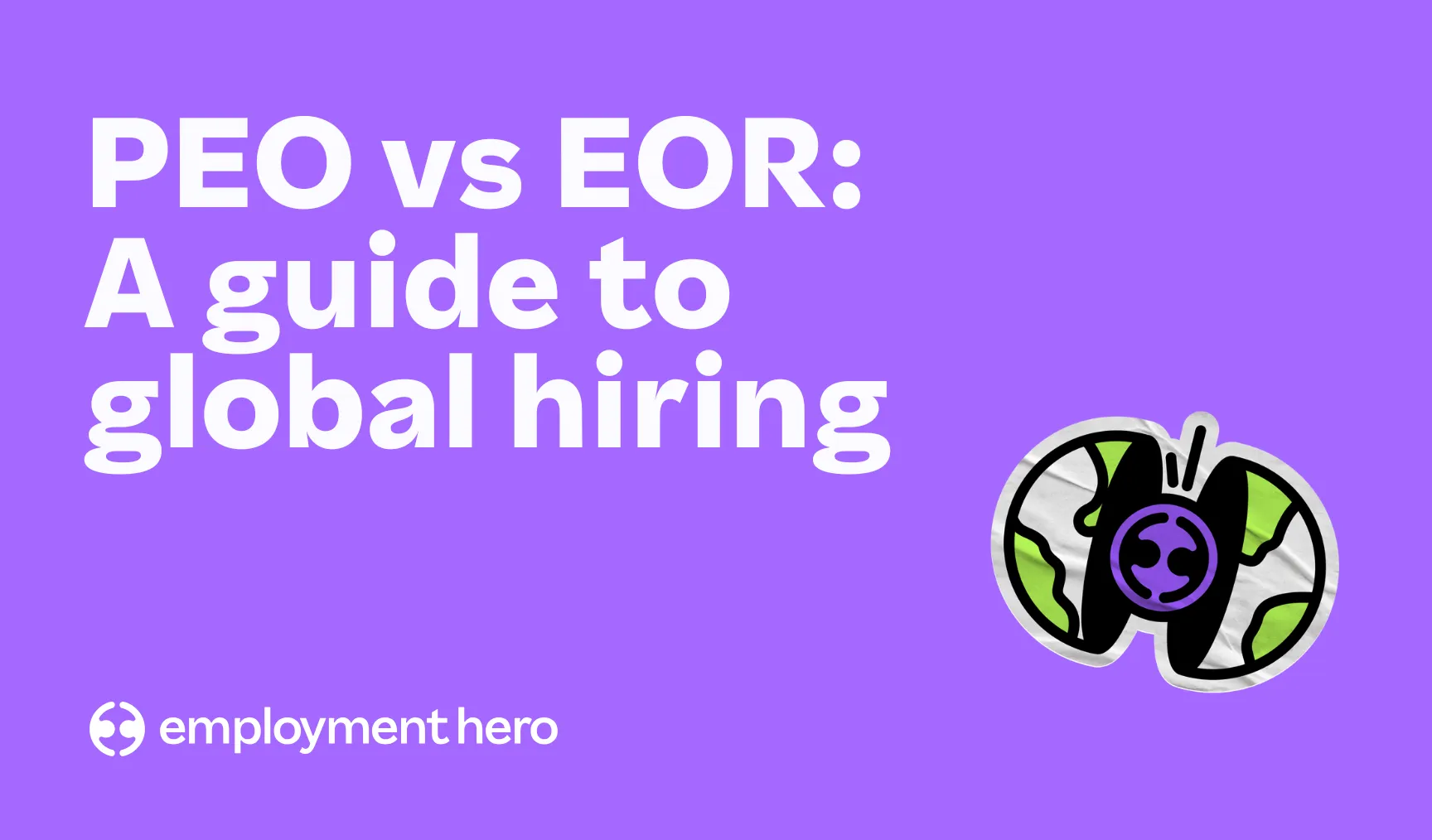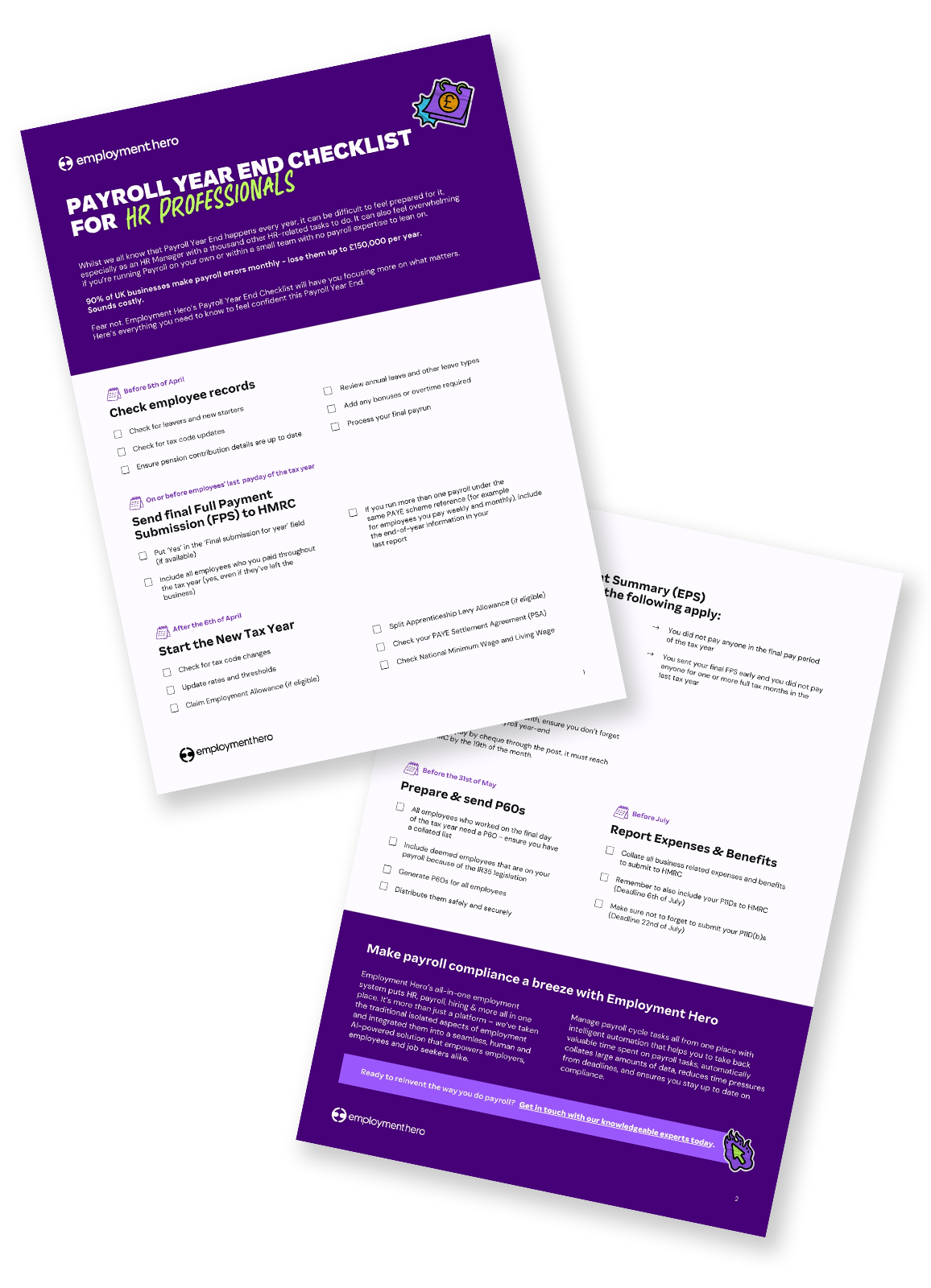How to get prepared for EOFY as a small business owner in the UK
Follow these tips to prepare like a pro for the UK end of financial year.

Unless you’re a seasoned payroll professional, the thought of the end of the financial year can strike dread into the heart of many business owners. However, it doesn’t need to be too tricky. A little planning and preparation can go a long way towards making the end of the tax year just another part of your business admin.
We’re here to take you through the end of the financial year (EOFY) processes so you can put more time back into your business.
The information in this article is current as at 15th March 2023 and has been prepared by Employment Hero Pty Ltd (ABN 11 160 047 709) and its related bodies corporate (Employment Hero). The views expressed in this article are general information only, are provided in good faith to assist employers and their employees, and should not be relied on as professional advice. The Information is based on data supplied by third parties. While such data is believed to be accurate, it has not been independently verified and no warranties are given that it is complete, accurate, up to date or fit for the purpose for which it is required. Employment Hero does not accept responsibility for any inaccuracy in such data and is not liable for any loss or damages arising directly or indirectly as a result of reliance on, use of or inability to use any information provided in this article. You should undertake your own research and seek professional advice before making any decisions or relying on the information in this article.
What are the legal requirements for business owners during EOFY?
The main legal requirements around the end of financial year involve preparing your annual accounts and sending your final payroll report to HMRC. This means you need to be up to date with your business finances, including payroll, expenses, VAT returns, personal tax returns and corporate tax filing. You will need to fill out certain forms and submit them to HMRC in order to determine how much tax you owe.
In the UK, the fiscal year runs from 6 April to the 5th April in the following year.
This means that April 6th 2023 will be the first day of the new tax year, marking your new VAT return period and tax year.
April 5th 2023 is the last day of the current tax year. The final Full Payment Submission (FPS) should be submitted on or before the last payday of the tax year. This is also the deadline for claiming tax overpaid for the 2018/19 tax year under self-assessment.
If you want to pay your employees’ benefits for the 2023/24 tax year through payroll, you must register online by 5th April 2023.
But beware! Not every business observes the same fiscal year. We use the set 12 month period to report and forecast in accounting and so that we can pay taxes for the previous year.
Self employed people, sole traders and partnerships follow the fiscal year, as does the PAYE (Pay as You Earn) system. Companies may have a different financial year as they can choose any period for their accounting year – accounting years for companies run from the date the company started trading as specified when they registered with Companies House.
So depending on whether you’re a sole trader, partnership, or simply running PAYE, there are specific tasks you’ll need to do at the end of every financial year.
Step 1: File a Self Assessment tax return
For self employed people, sole traders, partnerships and a few others, Self Assessment is the way to submit an income tax return. Partnerships will use the Partnership Tax Return (SA800).
Self Assessment tax returns can be submitted online using commercial software, or by completing paper forms. The deadline for paper forms is 31 October (or 31 January if you’re a trustee of a registered pension scheme or a non-resident company).
The Self Assessment tax return is a wide-ranging document, which will require a lot of information, including:
- your ten-digit Unique Taxpayer Reference (UTR);
- your National Insurance number;
- details of your untaxed income from the tax year, including income from self-employment, dividends and interest on shares;
- records of any expenses relating to self-employment;
- any contributions to charity or pensions that might be eligible for tax relief;
- P60 or other records showing how much income you received that you’ve already paid tax on.
Once completed, the form can be submitted to HMRC and the tax bill will be due by 31 January 2024.
For partnerships, if your partnership’s accounting date is between 1 February and 5 April and one of your partners is a limited company, the deadline for online returns is 12 months from the accounting date; while for paper returns it’s 9 months from the accounting date.
Step 2: Run final pay run for the tax year and submit your FPS and EPS
When you have finished processing all of your pay runs for the year, you need to notify HMRC.
This requires completing a series of tasks to ensure that you process your final payroll and are up to date with your year end values:
- Process, assess and update your final pay period for all pay frequencies in the 2022/23 tax year;
- Process any leavers who left on or before 5 April 2023;
- Submit the full payment submission (FPS) on or before the date your employees receive their pay;
- Submit your employer payment summary (EPS) for month 12 (if required).
You can do this within the RTI files by sending a Final Submission Indicator. When you submit this to the HMRC they will not expect any further submissions for that tax year and will effectively close the payroll for that year.
Using Employment Hero? The platform will automatically populate the final pay run indicator if it is the last period of the tax year, for example, month 12, however, you can untick this if required. If for any reason you miss sending this in the full payment summary (FPS) for your final pay run, you can manually set this flag within the employment payment summary (EPS) to notify HMRC instead.
What documents should small business owners keep throughout the year?
For all UK business owners, keeping records isn’t just a smart decision – it’s required for compliance.
Legally, companies are required to keep comprehensive financial records for at least six years, while sole traders must keep comprehensive financial records for at least five years, and all PAYE records for three years from the end of the tax year they relate to.
HMRC may charge a penalty of up to £3,000 per tax year for a failure to keep records or for keeping inadequate records.
Employee details should also be kept for at least six years.
As a business owner, you must keep the following records:
- all sales and income;
- all business expenses;
- VAT records if you’re registered for VAT;
- PAYE records if you employ people;
- records about your personal income;
- your grants, if you claimed through the Self-Employment Income Support Scheme – check how much you were paid if you made a claim.
You must keep some VAT records digitally – unless you’re exempt from following Making Tax Digital for VAT rules.
You should also keep general business records such as bank statements, cash books, cheque stubs, paying-in slips and till rolls.
Most small businesses with an income of £150,000 or less can use cash basis reporting. With this method, you only record income or expenses when you receive money or pay a bill. This means you will not need to pay Income Tax on money you have not yet received in your accounting period.
Having all the information already to hand, will make the end of financial year tasks so much easier.
From April 2026, Making Tax Digital for Income Tax will come into effect. This will make keeping digital records a legal requirement for most small businesses.
5 tips to get prepared for the end of financial year
1. Understand your deadlines
We know how hectic things can get for business owners – blink once and you’re right in the middle of winter. That’s why it’s really important to be across the deadlines for the financial year, whether that’s the final balance date, your provisional tax payments or the official filing deadline.
Stick them on your calendar or set notifications on your phone – whatever works to ensure that everything goes out on time.
2. Know where your records are
No one wants to be digging through a filing cabinet or frantically searching computer servers in the countdown to end of year. Make sure that your last year of records are in an easy-to-find and secure place, so that accessing critical information is quick and simple.
That’s where payroll software comes in handy, providing a single space for all that critical data that is updated consistently through the year.
3. Complete your payroll obligations for the financial year
Completing your last payday filing for the 2022-2023 tax year is a key task before you start working on the big tax return. Make sure your final pay run is complete and accurate so that you’re free to take stock of the last year without anything outstanding. The deadline for you to file the final submission with HMRC is the 19th April 2022.
When you have finished processing all of your pay runs for the year, you need to notify HMRC. You can do this within the RTI files by sending a Final Submission Indicator. When you submit this to the HMRC they will not expect any further submissions for that tax year and will effectively close the payroll for that year.
Using Employment Hero? The platform will automatically populate the final pay run indicator if it is the last period of the tax year, for example, month 12, however, you can untick this if required. If for any reason you miss sending this in the full payment summary (FPS) for your final pay run, you can manually set this flag within the employment payment summary (EPS) to notify HMRC instead.
4. Ensure your employee data is all up to date
Part of your end of financial year filing will include employee records, so make sure that all the information you have on file about your team is correct.
This might require some time checking in individually with your employees, so it’s crucial to factor in some time for them to respond and check themselves.
5. Look ahead to next year
While EOFY filing is all about looking back on the past year, it can also be a great chance to look ahead.
Collecting all this information and submitting the required data can be illuminating – is there any way you can make the financial year preparation easier next year? It could be a good opportunity to consider bringing in HR and payroll software to digitise the whole process in one easy-to-access portal.
Simplify your payroll and income tax return with Employment Hero
Bringing in payroll software like Employment Hero can be a gamechanger for your business, especially at the end of financial year. When surveyed, Employment Hero users said that their business was 52% more efficient with our software, and they used 65% less paper. On average, they experienced a 338% return on investment after three years with Employment Hero.
Our all-in-one HR, payroll and benefits platform makes record-keeping, reporting and workforce management easy at EOFY. Learn more about how we can help you at tax time by speaking with one of our small business specialists today.
Related Resources
-
 Read more: Setting employee expectations: Your guide to getting it right
Read more: Setting employee expectations: Your guide to getting it rightSetting employee expectations: Your guide to getting it right
Learn how to set clear employee expectations to boost productivity and engagement. Discover actionable tips and strategies for leadership success.
-
 Read more: PEO vs. EOR: A guide to global hiring
Read more: PEO vs. EOR: A guide to global hiringPEO vs. EOR: A guide to global hiring
Contents Expanding your business into new markets is a powerful growth strategy. But hiring talent globally introduces a maze of…
-
 Read more: How to build a global team without a local entity
Read more: How to build a global team without a local entityHow to build a global team without a local entity
Learn how to streamline your hiring and expand your UK business globally with an Employer of Record (EOR) without the…





















